
LAPUTA: CASTLE IN THE SKY
There it is! Right next to Lucy and her diamonds!

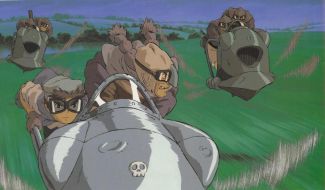 Review by: Craig "I Believe I Can Fly" Norris
Review by: Craig "I Believe I Can Fly" Norris
Length: 120 minute movie
Genre: Adventure, fantasy
Watched: All, dubbed
In the end, why do we watch movies? You can say anything you want about films that elaborate
on social issues or evoke strong emotions, but I believe that we watch movies to escape and be
entertained for a couple of hours. That is why, as a pure movie, this anime is quite possibly
Miyazaki's most successful project. Even though a certain golden statuette has other ideas.
Plot synopsis: Pazu is a young boy working a steady, boring job on a boiler for a silver mining
town. However, that all changes when a young girl named Sheeta literally falls into his lap.
Now he must help her evade both pirates and the military that want the mysterious stone that
hangs around her neck, as well as the secret that could reveal the location of the mythical floating
island of Laputa.
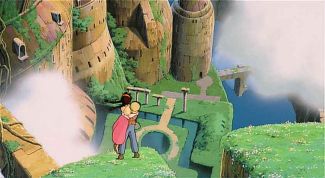 Artwork: Miyazaki's style is plainly evident, but the artwork has definitely started to show its
age. Character designs are pretty simple, with most of the innovation reserved for the setting and
vehicle designs. Backgrounds look good considering they are 20 years old, but by today's
standard they look a bit dull. The production values of Miyazaki's films have come a long way in
20 years, but this film does enough visually so that a viewer's eyes are moderately entertained.
Artwork: Miyazaki's style is plainly evident, but the artwork has definitely started to show its
age. Character designs are pretty simple, with most of the innovation reserved for the setting and
vehicle designs. Backgrounds look good considering they are 20 years old, but by today's
standard they look a bit dull. The production values of Miyazaki's films have come a long way in
20 years, but this film does enough visually so that a viewer's eyes are moderately entertained.
Music: The soundtrack is about par for the course for a feature film. It is entirely composed of
orchestra, with none of the tracks being particularly noticeable or memorable. Once again, the
production keeps in line with the conventions of most Miyazaki films in terms of music style and
quality. It works well for the film, but shouldn't be considered more than background music.
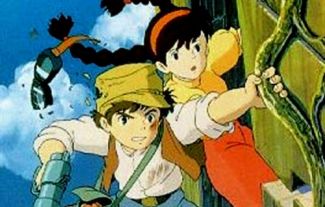 Characters: One aspect of this film that caught my attention immediately was the snappy dialog
between characters. There is a real effort made to develop characters just by having them talk to
one another, which I consider one of the most successful and entertaining ways to do so. The
characters themselves run a wide gamut of personalities. Sheeta is a meek young girl who is
being pursued by multiple people for reasons she does not fully understand. When Pazu becomes
involved, she often tries to dissuade him from helping her because she doesn't want anyone else
to get involved. Pazu is a spirited boy who becomes fast friends with Sheeta. When he finds out
that she is somehow connected to Laputa, he becomes even more determined to help her, as he
recognizes the opportunity to restore honor to his deceased father, who was severely defamed for
having claimed to see Laputa. Being orphans, Pazu and Sheeta strike an almost immediate bond
with one another. The forceful and boorish Dola is the leader of the pirates chasing after Sheeta.
She wants the stone around Sheeta's neck, believing it can find the location of Laputa and the
riches within. Several of the pirates she leads are her own sons. Muska is a shifty figure who
appears to be controlling the military in order to obtain Sheeta and her stone. Muska's reasons
for finding Laputa go far beyond mere greed, and he emerges as a truly despicable villain. All
this is learned not through exposition, but just by having the characters interact with each other.
Like my old creative writing teacher used to say, "Show, don't tell."
Characters: One aspect of this film that caught my attention immediately was the snappy dialog
between characters. There is a real effort made to develop characters just by having them talk to
one another, which I consider one of the most successful and entertaining ways to do so. The
characters themselves run a wide gamut of personalities. Sheeta is a meek young girl who is
being pursued by multiple people for reasons she does not fully understand. When Pazu becomes
involved, she often tries to dissuade him from helping her because she doesn't want anyone else
to get involved. Pazu is a spirited boy who becomes fast friends with Sheeta. When he finds out
that she is somehow connected to Laputa, he becomes even more determined to help her, as he
recognizes the opportunity to restore honor to his deceased father, who was severely defamed for
having claimed to see Laputa. Being orphans, Pazu and Sheeta strike an almost immediate bond
with one another. The forceful and boorish Dola is the leader of the pirates chasing after Sheeta.
She wants the stone around Sheeta's neck, believing it can find the location of Laputa and the
riches within. Several of the pirates she leads are her own sons. Muska is a shifty figure who
appears to be controlling the military in order to obtain Sheeta and her stone. Muska's reasons
for finding Laputa go far beyond mere greed, and he emerges as a truly despicable villain. All
this is learned not through exposition, but just by having the characters interact with each other.
Like my old creative writing teacher used to say, "Show, don't tell."
Plot: The plot is fairly basic, with a few mild plot twists thrown in here and there. The
organization and pacing is very impressive, with a good mix of non-stop action and quieter, more
sentimental moments. The film does not appear to have any hidden meanings or themes, and
sticks to telling a great adventure story. The plot follows tried-and-true formulas in storytelling,
and adapts them perfectly to the story to be told. It's just plain enjoyable, and doesn't require the
viewer to speculate much or read anything into it.
Editor's note: I would agree for the most part about the lack of underlying themes, but would also note that Miyazaki almost always has an underlying theme. I would note that I seem to remember one of his old fallbacks, the stupidity and destructiveness of war, is being used in this film. However, the film does win points for not becoming too preachy and only showing the point that it is trying to make. M.H.
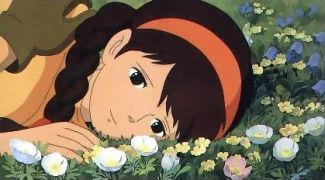 CHICKS!: The one area of the film that could use improvement (as far as I'm concerned, at any
rate) is the number and quality of chicks. Really the only chick worth much of anything here is
Sheeta, who gets points for being the reluctant heroine, but loses most of them for not being of
legal age. There's no doubt that she will more than likely mature into a very charming lady, so
patience is a virtue in this situation. Dola, thought spry for her age, is far, far past her prime. So
unless you're confined to a walker, look elsewhere for eye candy.
CHICKS!: The one area of the film that could use improvement (as far as I'm concerned, at any
rate) is the number and quality of chicks. Really the only chick worth much of anything here is
Sheeta, who gets points for being the reluctant heroine, but loses most of them for not being of
legal age. There's no doubt that she will more than likely mature into a very charming lady, so
patience is a virtue in this situation. Dola, thought spry for her age, is far, far past her prime. So
unless you're confined to a walker, look elsewhere for eye candy.
Overall: Most other Miyazaki films I have seen do at least one thing extraordinarily well, to the
point of being awe-inspiring. This film, however, doesn't focus on one or two things, instead
opting to be consistently good in all aspects and tell a really entertaining story. There have been
more meaningful films that sprang from the fertile mind of Hayao Miyazaki, but for straight
entertainment value, this one is tough to beat.
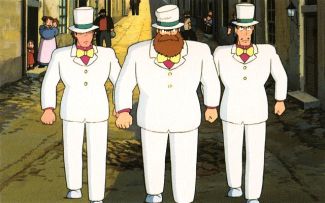 IN A NUTSHELL
IN A NUTSHELL
+ A great story
+ Character development through dialog
- Dated artwork
Rating: 8/10
Similar titles: - Howl�s Moving Castle
- Mononoke Hime
Return to Index


 Review by: Craig "I Believe I Can Fly" Norris
Review by: Craig "I Believe I Can Fly" Norris Artwork: Miyazaki's style is plainly evident, but the artwork has definitely started to show its
age. Character designs are pretty simple, with most of the innovation reserved for the setting and
vehicle designs. Backgrounds look good considering they are 20 years old, but by today's
standard they look a bit dull. The production values of Miyazaki's films have come a long way in
20 years, but this film does enough visually so that a viewer's eyes are moderately entertained.
Artwork: Miyazaki's style is plainly evident, but the artwork has definitely started to show its
age. Character designs are pretty simple, with most of the innovation reserved for the setting and
vehicle designs. Backgrounds look good considering they are 20 years old, but by today's
standard they look a bit dull. The production values of Miyazaki's films have come a long way in
20 years, but this film does enough visually so that a viewer's eyes are moderately entertained. Characters: One aspect of this film that caught my attention immediately was the snappy dialog
between characters. There is a real effort made to develop characters just by having them talk to
one another, which I consider one of the most successful and entertaining ways to do so. The
characters themselves run a wide gamut of personalities. Sheeta is a meek young girl who is
being pursued by multiple people for reasons she does not fully understand. When Pazu becomes
involved, she often tries to dissuade him from helping her because she doesn't want anyone else
to get involved. Pazu is a spirited boy who becomes fast friends with Sheeta. When he finds out
that she is somehow connected to Laputa, he becomes even more determined to help her, as he
recognizes the opportunity to restore honor to his deceased father, who was severely defamed for
having claimed to see Laputa. Being orphans, Pazu and Sheeta strike an almost immediate bond
with one another. The forceful and boorish Dola is the leader of the pirates chasing after Sheeta.
She wants the stone around Sheeta's neck, believing it can find the location of Laputa and the
riches within. Several of the pirates she leads are her own sons. Muska is a shifty figure who
appears to be controlling the military in order to obtain Sheeta and her stone. Muska's reasons
for finding Laputa go far beyond mere greed, and he emerges as a truly despicable villain. All
this is learned not through exposition, but just by having the characters interact with each other.
Like my old creative writing teacher used to say, "Show, don't tell."
Characters: One aspect of this film that caught my attention immediately was the snappy dialog
between characters. There is a real effort made to develop characters just by having them talk to
one another, which I consider one of the most successful and entertaining ways to do so. The
characters themselves run a wide gamut of personalities. Sheeta is a meek young girl who is
being pursued by multiple people for reasons she does not fully understand. When Pazu becomes
involved, she often tries to dissuade him from helping her because she doesn't want anyone else
to get involved. Pazu is a spirited boy who becomes fast friends with Sheeta. When he finds out
that she is somehow connected to Laputa, he becomes even more determined to help her, as he
recognizes the opportunity to restore honor to his deceased father, who was severely defamed for
having claimed to see Laputa. Being orphans, Pazu and Sheeta strike an almost immediate bond
with one another. The forceful and boorish Dola is the leader of the pirates chasing after Sheeta.
She wants the stone around Sheeta's neck, believing it can find the location of Laputa and the
riches within. Several of the pirates she leads are her own sons. Muska is a shifty figure who
appears to be controlling the military in order to obtain Sheeta and her stone. Muska's reasons
for finding Laputa go far beyond mere greed, and he emerges as a truly despicable villain. All
this is learned not through exposition, but just by having the characters interact with each other.
Like my old creative writing teacher used to say, "Show, don't tell." CHICKS!: The one area of the film that could use improvement (as far as I'm concerned, at any
rate) is the number and quality of chicks. Really the only chick worth much of anything here is
Sheeta, who gets points for being the reluctant heroine, but loses most of them for not being of
legal age. There's no doubt that she will more than likely mature into a very charming lady, so
patience is a virtue in this situation. Dola, thought spry for her age, is far, far past her prime. So
unless you're confined to a walker, look elsewhere for eye candy.
CHICKS!: The one area of the film that could use improvement (as far as I'm concerned, at any
rate) is the number and quality of chicks. Really the only chick worth much of anything here is
Sheeta, who gets points for being the reluctant heroine, but loses most of them for not being of
legal age. There's no doubt that she will more than likely mature into a very charming lady, so
patience is a virtue in this situation. Dola, thought spry for her age, is far, far past her prime. So
unless you're confined to a walker, look elsewhere for eye candy. IN A NUTSHELL
IN A NUTSHELL